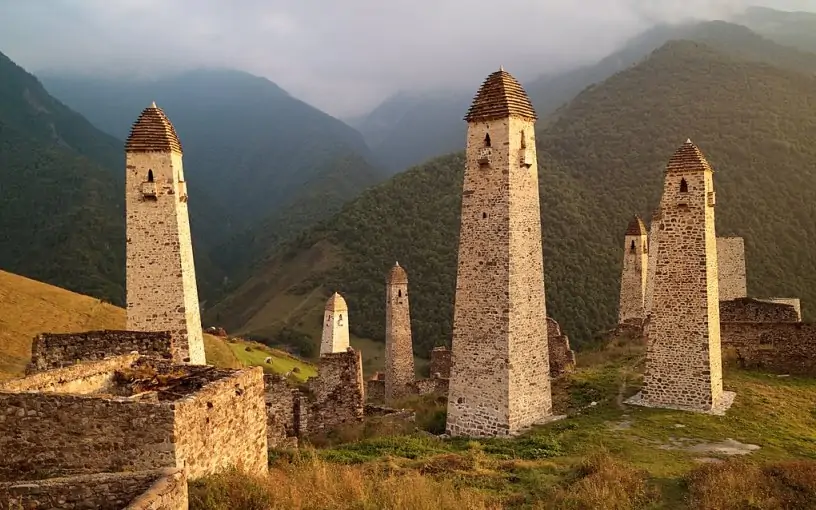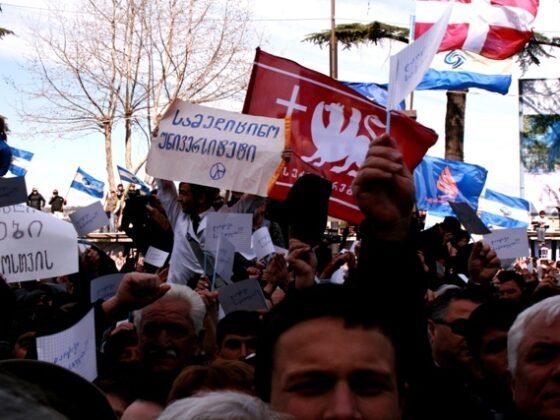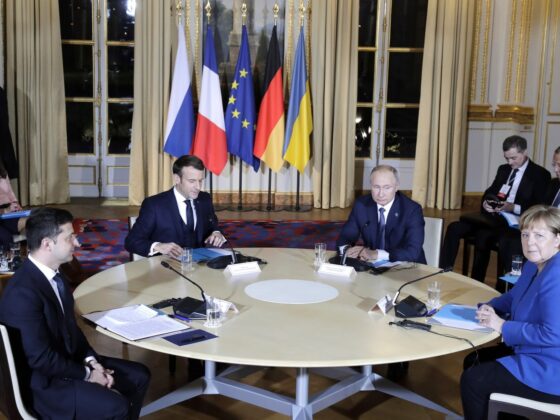(PONARS Eurasia Policy Memo) The drawing of administrative borders between Chechnya and Ingushetia caused protests in Ingushetia that began in October 2018, continued until March 2019, and culminated in the resignation of Ingushetia’s leader two months later. These protests reflect a persistent but largely unnoticed trend, the politicization of ethnicity in the eastern part of the North Caucasus (and also elsewhere in Russia). This policy memo looks at these development and their consequences, including for Russian statehood. Four potential pathways emerge for the future of the Chechnya-Ingushetia region. It can follow Moscow’s entreaty for co-existence within a Russian nation; unify around a common North Caucasus platform; seek restoration of the Chechen-Ingush republic; or establish ethno-nations based on ethno-linguistic divisions. While the first three possibilities seem remote, the fourth is conceivable and may pose risks to regional stability.
Business as Usual
The drawing of borders between Chechnya and Ingushetia was initiated in the fall of 2018 as a routine procedure. It was part of a countrywide process involving the demarcation of borders between Russia’s federal subjects. Some of these borders are still undefined and some are disputed. Moscow occasionally changes internal borders, even merges federal subjects, and frequently replaces local leaders.
The move that triggered public protests in Ingushetia appeared routine at first. Street protests have become a common reaction by the Russian population to certain administrative decisions. Of course, the Caucasus is a sensitive region compared to other parts of Russia, but this was not the reason why this border-drawing episode was special, and why its importance goes beyond the discontent of the minute fraction of Russia’s population that resides in Ingushetia.
In all likelihood, the officials who initiated the drawing of the long-undefined borders between Chechnya and Ingushetia did not expect the arrangements to cause such robust concerns and eruptions. The legacy of the 1990s, when attempts at land division led to outbreaks of violent conflict across the Northern Caucasus, has been ostensibly dealt with if not altogether forgotten. Drawing the border thus no longer seemed like a dangerous endeavor. It was also necessary since Ingushetia may well be the least territorially defined of Russia’s federal subjects. Ever since the conflict in the Prigorodny region in the early 1990s, Ingushetia’s border with Northern Ossetia-Alania has caused discontent among the Ingush public. And Ingushetia’s border with Chechnya was never officially drawn.
Until 1920, the entire North Caucasus was part of the Terek Oblast of the Russian state. There were no administrative borders between ethnic populations, nor were there any nations there in the modern sense of the word. Some territories were associated with particular clans, also known as teips, some of which later identified as Chechen or Ingush. Complicating things even more, most Ingush and Chechens identify with a teip union, called shakhar in Ingushetia and tukkhum in Chechnya, representing a traditional form of supra-familiar organization. In the two republics put together, there are fewer than 20 shakhars/tukkhums, most of them defined as Ingush or Chechen but some are mixed. The two ethnic groups also have a shared identity, Vainakh. Coined in the early 20th century, the term Vainakh is now widely used, including by Chechens and Ingush themselves, to denote both nations with their similar cultures and mutually understandable languages.
The USSR set up Chechen and Ingush autonomous regions in the 1920s but then merged them to form the Chechen-Ingush autonomous oblast (region) in 1934, which was raised to the status of autonomous republic in 1936. The Chechen-Ingush republic thus became one of the North Caucasus’ several bi-ethnic regions. There was no administrative border between Chechnya and Ingushetia, and the borders of the Chechen-Ingush republic changed over time. In 1944, when Stalin exiled the Chechens and the Ingush, he dissolved their republic, which was restored following the abolition of the two nations’ exile in 1957 but with slightly different borders; it lost some territories but gained some new ones.
Given the history, drawing borders between modern-day Chechnya and Ingushetia could not have been an easy task. Even at the time when Chechnya proclaimed its independence from Russia in the 1990s, whereas Ingushetia remained in the Russian Federation, the borders between both entities were not officially drawn and only existed based on an oral understanding between the leaders of the two nations. The two Chechen wars that followed Chechnya’s attempt at secession did nothing to increase clarity.
Mass Consolidation
Despite all of the above, in 2018, the presidents of Chechnya and Ingushetia, Ramzan Kadyrov and Yunus-Bek Yevkurov, signed an agreement defining the border between the two autonomous republics. The signing took place on September 26 and the agreement was to enter into force on October 16. Mass rallies began in Magas, the administrative capital of Ingushetia, on October 4, the day Ingushetia’s parliament voted on the bill. Protesters were unhappy with the territorial division prescribed by the agreement. Both land plots handed over to Chechnya, one near Goragorski village and the other taking up part of the Ingush State Nature Sanctuary and Ingushetia’s Erzi Nature Reserve, are ancestral lands of the Orstkhoy shakhar/tukkhum, or union of teips. The Orstkhoy happens to include both Chechens and Ingush, or more accurately, people who identify as either, since these identities can be fluid. As a result, both Chechens and Ingush can lay claim to the lands in question.
Though highland and unpopulated, these territories thus had symbolic importance. Tens of thousands took part in the protests. Not counting some cities that have federal status, Ingushetia is Russia’s smallest federal subject, with under half a million residents. Its small size enhances the sensitivity of territorial issues of any kind. It is likely that protesters included most of Ingushetia’s adult (largely monoethnic) population. The outbreak of discontent was powerful and consolidated.
While according to official data, 17 out of 25 members of Ingushetia’s parliament voted in favor of the agreement, some MPs immediately announced that the voting had been rigged. On October 30, Ingushetia’s Constitutional Court succumbed to pressure from the street movement and proclaimed the bill non-constitutional, rendering it void. On December 6, the Constitutional Court of the Russian Federation overturned this ruling, thereby closing the legal chapter. However, the protests continued until they were dispersed by the police on March 27, 2019. Some leaders of the protests were arrested and jailed for short prison terms (under two months). On June 24, Yevkurov resigned as president of Ingushetia, a decision endorsed two days later by President Vladimir Putin.
Politicized Ethnicity
The Ingush protests involved identity consolidation around a territorial issue. This form of consolidation has been manifest in the North and South Caucasus over the last 30 years, enabling the politicization of ethnicity across ideological, partisan, and social differences within ethnic groups. The territorial issue on hand was resolved in favor of Chechnya, an unsurprising outcome given that Ramzan Kadyrov’s political weight in Russia is many times that of Ingushetia’s elite. However, the protests also had other, more far-reaching outcomes.
First, the experience of mass mobilization and mass consolidation affected Ingushetia’s society, especially since the underlying problem was not resolved via a compromise but dealt with high-handedly by the government. One of Russia’s poorest regions, Ingushetia is strongly dependent on subsidies from the center, with federal subsidies amounting to 80 percent of Ingushetia’s budget. While this dependence acts as a deterrent to public protests, it does not rule them out as long as their causes are not addressed.
Second, the drawing of borders consolidated and mobilized the societies of both Chechnya and Ingushetia. No rallies took place in Chechnya, since none were called for. Besides, Chechnya’s regime leaves no room for protests or, indeed, any form of expression of public opinion. Kadyrov’s rule is harsh even by North Caucasus standards, but in this case, Chechen society supported its ruler. Even the émigré Chechen opposition supported the handover of the territories to Chechnya, reflecting ethnic mobilization around a territorial issue.[1]
What happened was that two ethnopolitical projects collided and one won. It amounted to the drawing of borders between the two nations in more ways than one. According to Moscow-based anthropologist Akhmet Yarlykapov (at a Caucasus Institute conference), the Chechen ethno-national project made a display of force, which can serve as an example to other ethno-national projects, including the Ingush one. Yarlykapov argues that, given the shortage of livable land and high birth rates in the highland parts of the North Caucasus, land division can become ethnicized and lead to further conflict.
Specifically in Ingushetia, 95 percent of the population lives in three valleys amounting to 15 percent of its territory (three-fourths in the Sunzha valley). While population density in the lowlands reaches 600 per square kilometer, the highlands feature difficult terrain in which it is hard to make a living. The fact that tensions in Ingushetia were triggered by the handover of unpopulated mountainous areas was another sign of the overall sensitivity of the land issue.
Possible Pathways
What does the future hold for Chechnya and Ingushetia? Strictly speaking, four options are on the table.
The first is the official Russian project of seeking the coexistence of ethnic groups within a civic Russian nation. At least in the eastern North Caucasus, this project is failing. Ingushetia and Chechnya have become largely monoethnic. Ethnic Russians are leaving Dagestan. Looking at differences between these republics, rather than homogenizing, parts of the North Caucasus are becoming increasingly heterogeneous, not just culturally, but even on the level of legal practices, such as bans on the sale of alcohol, dress codes for public officials, and so on.
The second option would be for the ethnic groups to unite on a common platform. There have been many projects of this kind, most of them based on Islamic identity, which is shared by all parts of the non-Russian North Caucasus except North Ossetia-Alania. On a political level, these projects manifest themselves as radicalized militant groups such as the Caucasus Emirate. Currently, all of them are in decline. Arguably, they have failed to generate supra-ethnic bodies or visions capable of bringing together the populations of the North Caucasus. Supporters of these unifying ideologies form networks, but they vary greatly across republics and ethnic groups in terms of their values, aims, and popular support.
The third option could be a Vainakh project to restore the Chechen-Ingush republic, uniting the two closely related ethnic groups in one territorial unit. It appears that Chechen elites have had aspirations for a project of this kind, but events, such as the drawing of borders described here, make its likelihood rather low. In a theoretical Vainakh republic, the Ingush would feel small and unimportant, especially given the dissimilar structure of the Chechen and Ingush regimes. In Ingushetia, the clans, or teips, play an important part in a complicated decision-making system that includes some checks and balances, and elements of inclusivity. In contrast, proto-statebuilding in Chechnya has resulted in an autocratic governance system. Chechen officials openly refer to their leader Ramzan Kadyrov as pachchakh, or “king” (from the Persian padishah).
The fourth and last option is the establishment of ethno-nations based on ethno-linguistic divisions. This may be the most dangerous option because the populations of the North Caucasus are ethnically mixed and borders do not reflect actual ethnic divisions. While the Chechen-Ingush republic has been abolished, two other bi-ethnic republics remain: Kabardino-Balkaria and Karachay-Cherkessia. From a wider North Caucasus perspective, the case of Chechnya and Ingushetia may well be the easiest of all because, with reservations and contentions, it is possible to draw a border between both entities. In mosaic places like Dagestan, land division would likely cause deep mass mobilization and conflict, especially in the event that Moscow weakens control or lets its subsidies to local elites run dry.
Conclusions
Given Moscow’s priorities as well as local trends, four potential pathways emerge for the future of the Chechnya-Ingushetia region. The first is to follow Moscow’s entreaty for co-existence within a Russian nation. The second is to unify around a common North Caucasus platform, and the third and least likely is to seek the restoration of the Chechen-Ingush republic. While the first three possibilities seem remote, there remains a fourth, which is conceivable despite posing risks of destabilization in the particular case of Chechnya and Ingushetia: to gradually establish ethno-nations based on ethno-linguistic divisions.
Arguably, it is the fourth scenario that is to some extent being played out in the Chechen-Ingush world. While not inevitable, its wider unfolding remains a possibility because the politicization of ethnicity is evidently in progress in the North Caucasus. Narratives and ideologies are emerging and taking hold. Networks are expanding, and leaders are gaining popularity and outreach. Since these societies are rather closed, and access is limited, these developments might not be well understood, but the North Caucasus is clearly changing.
Alexander Iskandaryan is the Director of the Caucasus Institute, Armenia.
[PDF]
[1] For an example, see the explanation by (exile) Tumso Abdurahmanov, who is an avid critic of Kadyrov’s regime, on his YouTube channel Abu-Saddam Shishani (in Russian).
Homepage image credit (license).
Memo #: 631
Series: 2











